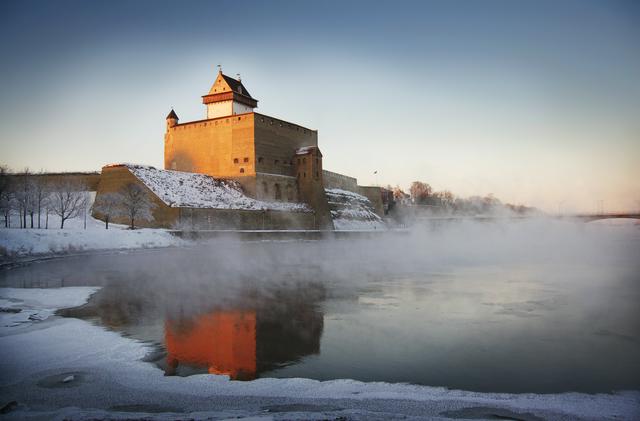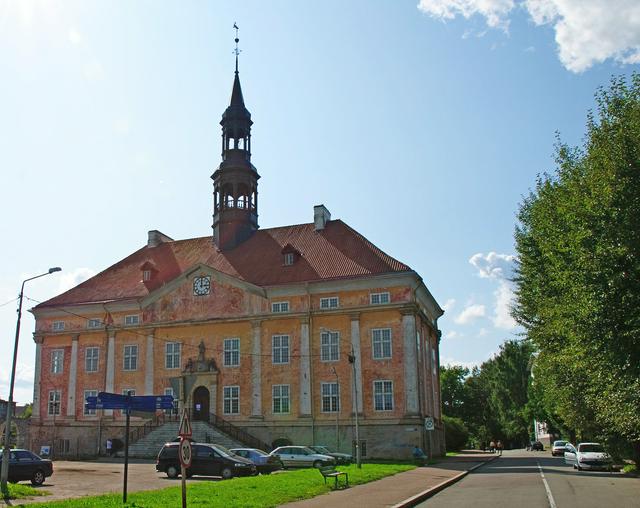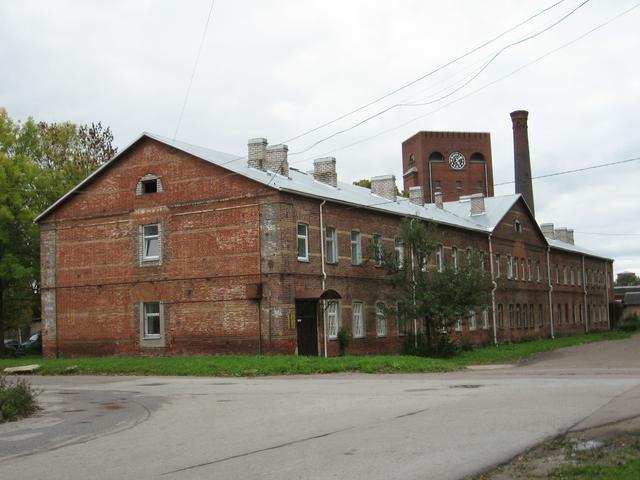Narva is the easternmost city in Estonia, at the Russian border.
 Most of the about 70,000 inhabitants are ethnic Russians. Narva-Jõesuu is a nearby seaside resort at the Gulf of Finland.
Most of the about 70,000 inhabitants are ethnic Russians. Narva-Jõesuu is a nearby seaside resort at the Gulf of Finland.
The city of Narva was founded by Denmark in the Middle Ages. Narva became part of the Swedish Empire, and during the Great Northern War, Swedish king Charles XII defeated the Russian Army here.
Due to the heavy damage of the Second World War, Narva had to be almost completely rebuilt. This is why the city is dominated by Soviet architecture today. Narva's "modern" Town Hall, for example, is a prime example of typical Soviet architecture.
Over 90% of the current population are Russian-speakers, mostly either Soviet-era immigrants from parts of the former Soviet Union and their descendants.
There’s plenty to do in Narva, concerts, annual festivals and open-air shows that take place both in the inner yard of the Narva Castle and elsewhere in the town, such as in the newly-built ice skating stadium.
- Tourist Information Centre, Puškini 13, +372 3560184. M-F 9-18:00, Sa-Su 10-15:00. The staff at the tourist information office on Pushkin street (next to Alexandr Kohvik) can offer plenty of help in fluent English.
Russian is spoken and understood by virtually everyone. If you are able to speak the Russian language, you will be fine. Estonian is spoken as the second language mainly by the younger generation (as learning Estonian at schools became compulsory after Estonia declared independence in 1991). Older people are likely to have zero knowledge of Estonian. English is spoken (or at least understood) by younger people, but the degree of proficiency may vary greatly. Street signs are Estonian-only or in Estonian and English.
Tourist Information Centre, Puškini 13, +372 3560184. M-F 9-18:00, Sa-Su 10-15:00. The staff at the tourist information office on Pushkin street (next to Alexandr Kohvik) can offer plenty of help in fluent English.


- Hermann Castle / Narva Museum, St.-Peterburi mnt. 2., +372 3599 230. M-Su 10:00-18:00, winter: W-Su 10:00-18:00. Founded at the end of the 13th century by the Danes. In 1347, the Danish king sold Northern Estonia to the Livonian Order. After that the castle was turned into a convent with a massive tower named Hermann. During World War II the castle and the tower were severely damaged. After 30 years of restoration, the castle was reopened in 1986. The Castle tower overlooks the Ivangorod castle on the Russian side of the river and offers an eclectic display of Estonian and Narva history. The park around the Hermann Castle is for free and allows for good pictures. Tickets are €4.
- Pimeaed (Blind Garden), Pimeaia tn. This is Narva’s oldest part, an example of park architecture from the end of the 19th century. Though, you might be surprise what that just means.
- Narva Bastions, Raja tn, +372 3565002. M-F 10:00-18:00 Sa Su 10:00-16:00. Seven bastions were built in the 17th century: Victoria, Honor, Gloria, Fama, Triumph, Fortuna, and Spes. Work has been started to dry and light the bastions. Victoria bastion is the largest and most impressive one of all bastions, with 2-storey casemates, and marked here. €4/2 adult/child.
- The Lords Resurrection Cathedral, Bastrakovi tn 4, +372 3573226. It was built in 1890-1896 for the Orthodox Christian workers of Kreenholm Manufactory. The architectural style comes from Byzantine tradition. You can see three part iconostasis and 17th century’s crucifix of Christ. The bombing of the city in 1944 during the Second World War left only the church untouched.
- Narva Art Gallery, Vestervalli tn 21, +372 3592151. 10:00-18:00. The gallery is the art centre of East-Viry County. It is located in an 18th-century ammunition warehouse. In addition to the permanent collection, exhibitions of modern Estonian and Western European art are organized and a traditional art party takes place on the last Sunday in May.
- Narva Town Hall, Raekoja plats 1, +372 3599230. 10:00-18:00. Erected in 1668-1671, German, Swedish and Italian architectural influences are mixed in the building style of the Town Hall. The design stems from Georg Teuffel, a former architect from Lübeck. Approved in Stockholm, the design was amended by Dutch classicism elements. Nikolaes Millich built the Baroque entrance portal. Heavily damaged during World War II, restoration was carried out between 1956-1964. Not open to public.
- Narva Alexander Church, Kiriku tn 9, +372 3561027. Built in 1881-84 by Otto Hippius, who also constructed the Sangaste Castle in South Estonia, the building represents historicism with elements of classicism. The building was financed by Ludwig Knopp, owner of the Krenholm Manufacture. In commemoration of the deceased Alexander II, his name was used. The Alexander Church was damaged during both world wars. The bell tower was destroyed in 1944 along with the Walcker organ that was located there. Between 1962 and 1990 the church was not active but used mainly as storehouse. Today the church's bell tower has been restored. You can visit the bell tower and the observation platform installed there, as well as a museum where artworks from the 14th to 21st century are displayed. Tower & museum: €3.
- Kreenholm area and Kreenholm Textile Factory, Joala tn 20. The famous Kreenholm Textile Factory was built on the shore of the waterfall in the 19th century, and was the largest factory in the Russian Empire at that time. In 1913 over ten thousand people worked there! A compact complex of industrial architecture developed around the factory that included the factory, a hospital, workers' barracks, directors' houses, and Kreenholm Park.
- T-34 Tank, Jõesuu tn (Between Narva and Narva-Jõesuu. The monument commemorates battles of World War II and indicates breakthrough of Soviet forces. Narva’s tank is the only such memorial being exhibited in Estonia from the war until today.
Hermann Castle / Narva Museum, St.-Peterburi mnt. 2., +372 3599 230. M-Su 10:00-18:00, winter: W-Su 10:00-18:00. Founded at the end of the 13th century by the Danes. In 1347, the Danish king sold Northern Estonia to the Livonian Order. After that the castle was turned into a convent with a massive tower named Hermann. During World War II the castle and the tower were severely damaged. After 30 years of restoration, the castle was reopened in 1986. The Castle tower overlooks the Ivangorod castle on the Russian side of the river and offers an eclectic display of Estonian and Narva history. The park around the Hermann Castle is for free and allows for good pictures. Tickets are €4.
Pimeaed (Blind Garden), Pimeaia tn. This is Narva’s oldest part, an example of park architecture from the end of the 19th century. Though, you might be surprise what that just means.
Narva Bastions, Raja tn, +372 3565002. M-F 10:00-18:00 Sa Su 10:00-16:00. Seven bastions were built in the 17th century: Victoria, Honor, Gloria, Fama, Triumph, Fortuna, and Spes. Work has been started to dry and light the bastions. Victoria bastion is the largest and most impressive one of all bastions, with 2-storey casemates, and marked here. €4/2 adult/child.
The Lords Resurrection Cathedral, Bastrakovi tn 4, +372 3573226. It was built in 1890-1896 for the Orthodox Christian workers of Kreenholm Manufactory. The architectural style comes from Byzantine tradition. You can see three part iconostasis and 17th century’s crucifix of Christ. The bombing of the city in 1944 during the Second World War left only the church untouched.
Narva Art Gallery, Vestervalli tn 21, +372 3592151. 10:00-18:00. The gallery is the art centre of East-Viry County. It is located in an 18th-century ammunition warehouse. In addition to the permanent collection, exhibitions of modern Estonian and Western European art are organized and a traditional art party takes place on the last Sunday in May.
Narva Town Hall, Raekoja plats 1, +372 3599230. 10:00-18:00. Erected in 1668-1671, German, Swedish and Italian architectural influences are mixed in the building style of the Town Hall. The design stems from Georg Teuffel, a former architect from Lübeck. Approved in Stockholm, the design was amended by Dutch classicism elements. Nikolaes Millich built the Baroque entrance portal. Heavily damaged during World War II, restoration was carried out between 1956-1964. Not open to public.
Narva Alexander Church, Kiriku tn 9, +372 3561027. Built in 1881-84 by Otto Hippius, who also constructed the [[South Estonia#See|Sangaste Castle in South Estonia]], the building represents historicism with elements of classicism. The building was financed by Ludwig Knopp, owner of the Krenholm Manufacture. In commemoration of the deceased Alexander II, his name was used. The Alexander Church was damaged during both world wars. The bell tower was destroyed in 1944 along with the Walcker organ that was located there. Between 1962 and 1990 the church was not active but used mainly as storehouse. Today the church's bell tower has been restored. You can visit the bell tower and the observation platform installed there, as well as a museum where artworks from the 14th to 21st century are displayed. Tower & museum: €3.
Kreenholm area and Kreenholm Textile Factory, Joala tn 20. The famous Kreenholm Textile Factory was built on the shore of the waterfall in the 19th century, and was the largest factory in the Russian Empire at that time. In 1913 over ten thousand people worked there! A compact complex of industrial architecture developed around the factory that included the factory, a hospital, workers' barracks, directors' houses, and Kreenholm Park.
T-34 Tank, Jõesuu tn (Between Narva and Narva-Jõesuu. The monument commemorates battles of World War II and indicates breakthrough of Soviet forces. Narva’s tank is the only such memorial being exhibited in Estonia from the war until today.
- Mravinski's International Music Festival. in May.
- Narva Town Days. in July.
- Narva History Festival. in August.
Mravinski's International Music Festival. in May.
Narva Town Days. in July.
Narva History Festival. in August.
- Second hand shopping, Pushkin 13. There are many second hand stores in Narva. Most of them sell assorted clothing and shoes from the 1980s and 1990s. The one next door from Alexandr has a selection of Soviet and World War II artifacts, jewelry and memorabilia.
There are a few shopping centres along Tallinn street.
- Narvacentrum, Tallinna mnt. 47.
- Fama, Tallinna mnt. 19c.
- Astri, Tallinna mnt. 41. Has also a cinema and a bowling hall.
Second hand shopping, Pushkin 13. There are many second hand stores in Narva. Most of them sell assorted clothing and shoes from the 1980s and 1990s. The one next door from Alexandr has a selection of Soviet and World War II artifacts, jewelry and memorabilia.
Narvacentrum, Tallinna mnt. 47.
Fama, Tallinna mnt. 19c.
Astri, Tallinna mnt. 41. Has also a cinema and a bowling hall.
- Cafe Aleksandr, Pushkini tänav 13. Tu-F 11:00-18:00, Sa Su 11:00-15:00. Relatively low prices, clean and cosy interior. More than 100 dishes of European and Russian cuisine including salads, soups, pelmeni, fish, chicken and meat courses, pancakes and desserts. Nearby the cafe is Narva castle, Narova river and the tourism information office. Tourist groups of up to 40 people are welcome!
- Hesburger, Tallinna mnt 19C. M–Su 10:00–20:00. Finnish fast food chain.
- McDonald's, Tallinna mnt 37, +372 55617016. M–Th Su 08:00–00:00, F–Su 08:00–01:00. fast food
- Peetri Pizza, Tallinna mnt 30B, +372 3544001. Daily 10:00–22:00. pizzeria
- Peetri Pizza, Kreenholmi 50, +372 3564030. Daily 10:00–22:00. pizzeria
- Pappa Pizza, Kerese 3, +372 3350665. Daily 10:00–22:00. pizzeria
For more expensive dining options, consider the restaurants in the hotels in the sleep section.
Cafe Aleksandr, Pushkini tänav 13. Tu-F 11:00-18:00, Sa Su 11:00-15:00. Relatively low prices, clean and cosy interior. More than 100 dishes of European and Russian cuisine including salads, soups, pelmeni, fish, chicken and meat courses, pancakes and desserts. Nearby the cafe is Narva castle, Narova river and the tourism information office. Tourist groups of up to 40 people are welcome!
Hesburger, Tallinna mnt 19C. M–Su 10:00–20:00. Finnish fast food chain.
McDonald's, Tallinna mnt 37, +372 55617016. M–Th Su 08:00–00:00, F–Su 08:00–01:00. fast food
Peetri Pizza, Tallinna mnt 30B, +372 3544001. Daily 10:00–22:00. pizzeria
Peetri Pizza, Kreenholmi 50, +372 3564030. Daily 10:00–22:00. pizzeria
Pappa Pizza, Kerese 3, +372 3350665. Daily 10:00–22:00. pizzeria
You should probably consider a more cosmopolitan city like Tallinn or Tartu for nightlife.
While Estonia is generally very safe, Narva systematically ranks as the country's most dangerous place. Most murders, aggravated assaults, robberies, and car thefts in Estonia occur here.
As in any other Russian majority town, take extreme care if you're dark-skinned. Avoid non-touristic places and stay clear of bars and pubs at all costs, especially at night as skin-heads are known to be active here.
- Narva-Jõesuu – A small resort town at the mouth of the river Narva, 14 km northwest.
- Sillamäe – A beautiful coastal town in the east and formerly closed city with the best ensemble of Stalinist architecture in the entire Baltics. Built after the war with an uranium processing plant, successfully redesigned after Estonia's independence.
- Rakvere – Estonia's fifth largest city, west-wards, famous for its Punk and Rock festivals and spirit.
- Kuremäe – Contains the famous Pukhitsa convent/nunnery, the only Orthodox monastery in the whole of Estonia.
- Mustvee – More than halfway to Tartu is this small and relaxing fishing village.
- Tartu – Museum-rich and Hanseatic city on the banks of the Emajõgi River. Also, Estonia's second-largest and oldest city, intellectual hub famous for its universities, and a lively student city.
- Lahemaa National Park – On the coast within an hour east (50 km) of Tallinn. Given its size it is the largest park in Estonia and one of Europe's biggest national parks, with 1000 km2 of bogs, trails, and forests.
- Tallinn – The financial and cosmopolitan centre of Estonia. Beautiful and expensive.
- Ivangorod – On the Russian side of the river, and Saint Petersburg.
